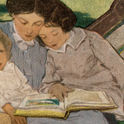A fortnight ago, a friend sent me a light-hearted reminder that it was her birthday in a few days. She does this every year.
The problem is that she died a couple of years ago, and I simply cannot bear to block her (and her digital messages) from my account. I wouldn’t want to either: her satirical messages still make me smile. Like millions of other people, her continued digital life serves as a reminder of her unique identity. Her messages from the grave are a profound example of a contemporary revolution in dying and death.
This revolution even precedes an individual’s death. In their final weeks, days, and hours, those with fatal illnesses have begun to enthusiastically tweet and blog about this most significant of experiences. The process of dying, as opposed to the “event itself,” has once again moved into public view.
After death, the deceased’s Twitter feed or Facebook page is often taken over by relatives and friends—using the same picture and profile the person had control of when alive. The power of this new afterlife can be seen in what happened after the death of the
Guardian columnist Michele Hanson on 1st March. Hanson could be seen reporting her own death on her Twitter feed (which had been taken over by her daughter). Her account then served as a forum for hundreds of heartrending memories of and memorials to Hanson’s life. Hanson appeared to be retweeting tributes to herself.
In such ways, friends, family, and even acquaintances can participate in the creation of an afterlife on behalf of the deceased person, engaging emotionally—and creatively—with what used to be the ultimate taboo. Social media websites have become the new memorial books. And whereas memorial books are usually closed as soon as the funeral or memorial service is over, digital conversations about, or even appearing to involve, the deceased, can rumble on much longer.
Where will this take us? Could the life-death divide cease to be quite as clear as it once seemed? Perhaps it says something about the way we die now that Pixar’s latest hit animation,
Coco, plays out in the penumbra between this world and the next—where souls are departed, but not yet forgotten.
Every year, 525,000 people in England and Wales draw their last breath. Some die peacefully in their sleep; others seethe with indignation until their last breath. Friends and family who witness the demise of someone they love feel helpless and distressed. Worlds are turned upside-down. The manner in which we die, and the way survivors grieve, is a marker of our individual character and collective culture. Death is inevitable, but there is nothing inevitable about how it is thought or “practised.” How we die has evolved in more ways than we might imagine. The current revolution—the digital afterlife—follows, and in some senses reverses, three earlier disruptions over the previous century.
?Doctors play God?
The first is secularisation, which is the easiest to exaggerate. In his poem “Aubade” (1977), Philip Larkin claimed that religion is a “vast moth-eaten musical brocade / Created to pretend we never die.” Pretending that we are immortal is one fantasy: a more invidious illusion is that God has died. Remember: prayers are still murmured over dying and dead bodies; most funerals continue to take place in places of religious worship.
Nevertheless, there has been a waning in the efficacy of appeals to dying people that they should fear God’s omnipresence and omnipotence, and especially in the potency of the warnings about the literal existence of hell-fires. Fewer people came to call on a deity when dying or watching a loved one die. Fear of God’s judgement was replaced by the metaphor of journeying into an unknowable abyss—a chilling “nothingness.” Faced with extinction, modern commentators are more likely to recite those other lines in Larkin’s poem, which recognise “the total emptiness for ever, / The sure extinction that we travel to / And shall be lost in always. Not to be here, / Not to be anywhere.” Death has become an existential void of non-existence, the ultimate denial of the all-conquering modern self—and a taboo we struggled to deal with.
Into this void steps the white-coated physician. This is the second great 20th-century development in the culture of dying. While in the mid-19th century less than one-tenth of deaths took place in hospitals, public lunatic asylums, or workhouses, in the UK today over half of people die in a hospital bed or corridor. The professionalisation of the end-of-life specialists was partly responsible for driving this change.
In addition, smaller families, an ageing population, the greater propensity of women to work outside the home, and increased mobility of familial members have reduced the resources necessary for the efficient management of a domestic death. Relatives and friends also prefer experts to take responsibility for their dying loved ones.
A recent survey carried out on behalf of the Department of Health found that 74 per cent of 49,000 people surveyed believed that the right place for a person to die was a hospital. Yet only 3 per cent of these respondents stated that the dying person him- or herself would want to die in such a setting. Bluntly stated: hospital and hospice deaths are considerably more convenient for the family than they are for the patient.
And the removal of the act of dying from private homes and into hospitals worked—paradoxically—to make it an increasingly private event. Denied access to the intimacy of a domestic deathbed, fewer people witnessed the death of other people first-hand: they were increasingly uncertain about how they should comport themselves in the face of death or what “feeling rules” should apply. Death’s script became more alien and mysterious.
_____________________
Now try: Philip Ball on growing a second brainCathy Rentzenbrink on why some things are worse than deathProspect's podcast with Joanna Bourke, Philip Ball and Cathy Rentzenbrink
_____________________
With medical personnel, rather than clerics, presiding over death’s terrors, questions relating to the meaning of life also tend to be sidelined. The medicalised gaze depicts human subjectivity as residing primarily in the corporeal body: death becomes a decisive event of the flesh, as opposed to a process involving the interaction between body and soul. Consciousness is nothing more than a physiological process.
According to this medical model, the gravest insult to both the dying person and the physician is pain. One of the consequences of the embargo on physical distress is the more intensive use of effective painkillers for the dying patient. As a business model, it grew dramatically from the 1980s: according to one American survey, sales in this niche market, where drugs are only likely to be administered to an individual for a few days, had already reached $1.5bn by 2005.
The remarkably rapid spread of hospices furthered this shift. It was as late as 1967 that Cicely Saunders opened St Christopher’s Hospice, generally considered to be the first one in the UK, dedicated to “total care” of the terminally ill. It was at the crest of a movement that set out purposefully to improve life for the dying. As it spread, fear and pain among the terminally ill has come to be regarded as a sign of medical incompetence.
This shift in the meaning of pain was part of a seismic adjustment in the dying person’s understanding of the meaning of their own suffering. Christian interpretations of pain in terminal illness could be relentlessly upbeat: the person who endured agonising flames of pain in this world would be spared them in the next one. Bodily distress was seen as a mechanism for drawing people into God’s embrace, and thus ensuring salvation.
A sudden death was feared because it did not give people time to purify their soul in anticipation of the Great Judgement in the hereafter. Stoicism was an integral part of the “good death.” Crucially, death’s agonies would also provide spiritual and moral guidance for observers as well as patients. Physicians, family members, preachers, and even strangers would take heed, turning off the highway of iniquity on to the path of goodness.
? No pain, we gain ?
Nothing could be further removed from the business of dying in the late 20th century. By then, for many people, a sudden death became the preferred variety. Perversely, though, organ transplants, life-support systems, intravenous nutrition, dialysis and resuscitation techniques have dramatically prolonged the process of dying in ways that are often inhumane (see Cathy Rentzenbrink in the April issue of
Prospect).
Fear of the excessive prolongation of life, or being obliged to stay alive after all pleasure has been removed, has become more dominant than the fear of death itself. You might have thought that preserving life at all costs would be the only demand in a self-absorbed society, but it turned out that “quality of life” could trump it—together with any advantages that might be achieved by purging the soul.
The medicalisation of death not only altered ideas about pain: it also changed ideas about whether death was (or should be) frightening. For many theologians of the early 20th century and earlier, it had been considered appropriate to fear death. In the words of William Booth, founder of the Salvation Army, “Nothing moves people like the terrific. They must have hell-fire flashed before their faces, or they will not
move” towards the altar of salvation. Fear is the rock on which Christ built his church.
In contrast, physicians set themselves the opposite task: reassurance. In the words of the Edwardian clinician William Osler, four-fifths of people on their deathbeds were emotionless: “like their birth, their death was a sleep and a forgetting,” he told his students. Since consciousness relied on adequate amounts of healthy blood reaching the nerve centres, and because the brain was the first organ to be deprived of blood, the seriously ill rapidly lost all apprehension of pain or fear. According to such ways of thinking, once the corporeal “self” weakened, the spirit had already departed.
Harvesting the body
The corporeal self that dies, however, is also increasingly fragmented and commodified. New medical technologies and ways of thinking view the body as a jigsaw-like entity consisting of interchangeable parts.
Evidence of “malfunctioning” leads to calls for replacement—organ transplants, for example; faulty bodily processes can be replicated by machines—such as dialysis. Individuals are no longer unique, indivisible. (Philip Ball’s meditation on his real-life experience of having a “second brain” grown in a lab, also in this month's issue is a forceful reminder that science still has some way to go yet in redefining basic ideas of the self, and its expiration.) Indeed, at the very end, people’s bodies can be kept “alive” just long enough to become the source of life for other bodies that would, otherwise, be “dying.”
The separation of the “self” from the “body” facilitates, and controls the way we approach, the marketing of those “parts.” Procuring, preparing and replacing bodily organs is extremely expensive, as are the technologies for imitating healthy physiological activities. Left to its own devices, the neoliberal marketplace is an insatiable taskmaster.
In the affluent west, professional bodies and governments impose some strictures. But there are rising concerns with the regulation of bodily parts by national health regulatory groups, biotechnological industries and trans-national corporations. In some parts of the world, it is entirely ungoverned terrain. Even here, we can get uneasy. When Health Secretary Jeremy Hunt recently launched plans for an “opt-out” system of organ donation (meaning that it would be presumed that everyone donate their organs on their death, unless they had explicitly registered dissent), concerns were raised.
Might the organs, tissues and blood of certain groups of people—minorities, for example—be “harvested” with undue haste? Thousands of (other) lives would undoubtedly be saved, but where were the safeguards? The commodification of human organs represents the ultimate in biopolitics—or the political control of populations at the biological and species level. If humanity ever was, in Kant’s phrase “the Kingdom of Ends,” then it is so no longer.
? Digital ways of death ?
All my first three transformations—secularisation, medicalisation and commodification—can be understood within the terms of another philosopher, Descartes, and the sharp distinction he drew between mind (
res cogitans) and body (
res corpus).
More recently, however, technology has begun to gnaw away at this understanding of life, replacing it with a more informational conception. Like the pre-Protestant, pre-Descartes self, we are now ready to define ourselves, not by introspection, but in terms of a community. This new idea of the self, in turn, disrupts the old mechanical conception of dying and dead bodies with something new—
res digitalis.
In the digital age, humans are defined by their web of connections, including online data storage and communication systems. In sharp contrast to the period before the 1990s,
res digitalis has catapulted death once again into its traditional dominant position—with one major twist: dying and death are exposed within a vastly extended public sphere.
Email, blogs, photo-streaming and social-media accounts allow dying to be shared, as casually as we share more banal aspects of life, like what we did on a night out or had for lunch. This has some negative aspects. Cyberspace is awash with corporate interests. Digital-age dying has reinforced consumerism: “alternative” therapies turn out to be expensive and exploitative of people’s fears and anxieties.
It can also encourage digital narcissism and the imposition of conservative gender norms. Breast cancer websites, for example, exhort women to put on a “brave face” and, above all, never lounge about the house in a shabby dressing gown. Victoria’s Secret underwear must continue to be shared with one’s lover or spouse.
Nevertheless, ill and dying people, as well as their relatives and carers, have enthusiastically embraced new media and new forums, in order to write about their hopes, fears, fantasies, and plans for the future, including their own memorials. Digital sites not only allow them to communicate intimately with, potentially, millions of people all over the globe, but also to provide a space where self-reflection is fostered and creativity is positively encouraged.
The fundamentally interactive nature of these communications makes them quantitatively and qualitatively different from print-based pathographies, or sickness narratives. They are also fundamentally anti-elitist, defiantly claiming that the experience of “ordinary sufferers” is of greater validity than that of the “expert” priest, physician, psychiatrist or counsellor.
Not only have the physical limits to our identities been extended spatially (it is easier for me to share my fears of a tumour to someone in Sierra Leone than to a friend next door), but our identities also extend post-death, beyond the grave. Like my dead friend who continues to remind me to buy her a birthday present, the longevity of our digital selves partly explains the popularity of memorial websites and Facebook pages. The dead are not forgotten. The emotions engendered by such encounters in cyberspace weave into and out from the everyday sociability of our lives.
"A spiritual sense of a paranormal 'other' never really disappeared"
This change may only be obvious at this stage with the likes of Michele Hanson, who was a newspaper columnist with a following online; but in time, as more and more of all our selves are defined on the web, we shall see it for everyone. The late 20th century injunction to turn the funeral into a day of celebrating a life, will become a celebration without obvious end. The digital self may give rise to many problems, but it may also be making us less selfish. As such, the digital twist on dying has also undermined the earlier secular twist on dying in a more self-absorbed age.
That is a good thing too. After all, a spiritual sense of a paranormal “other” never really disappeared—it simply went underground: dying people continued to pray privately, while publicly submitting to the best treatments that a highly technological, medicalised profession could offer them.
Today, religions have become enthusiastic users of social media, not only to share information about spiritual activities but also to provide reassurances of an afterlife for the dying members of their congregation and those people mourning the death of a loved-one or friend. More commonly, dying-blogs attest to non-denominational spirituality, often in highly idiosyncratic ways, but sincere nonetheless.
Res digitalis has been important in encouraging people to re-engage with the “big questions” of the meaning of life and death. It has caused a shift in the processes of dying and grieving, enabling us to transcend the anxieties of the previous century, and to allow more grieving to be done in public, without any need to reinstitute the Victorian black armband. It also emphasises that permeable border between the dead and the living, and therefore points the way to new and more creative ways of being human.













